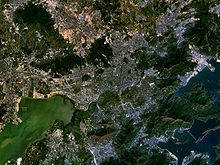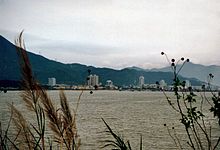Shenzhen
![]()
This article is about the place. For the comic strip of the same name, see Shenzhen (comic strip); for the asteroid, see (2425) Shenzhen; for the automobile manufacturer, see Shenzhen Baoneng Motor.
Shenzhen, German also Schenzhen (Chinese 深圳市, pinyin![]() ), is a sub-provincial city in Guangdong Province of the People's Republic of China.
), is a sub-provincial city in Guangdong Province of the People's Republic of China.
Shenzhen is located in the southern part of the province and borders the Hong Kong Special Administrative Region to the south. The planned city is a major city for foreign investment and one of the fastest growing cities in the world due to its status as a special economic zone. Shenzhen is the city with the highest per capita income in China (excluding Hong Kong and Macau). The mainstays of the local economy are the electronics and telecommunications industries.
Shenzhen has been part of the Creative Cities Network as a UNESCO City of Design since 2008.

Shenzhen Municipalities
Geography
Location
The boomtown Shenzhen is located in the south of Guangdong province on the Pearl River. The city area covers a size of 1991 km². It is separated from Hong Kong by the Sham-Chun and Sha-Tau-Kok rivers.
Shenzhen is located about 100 km southeast of the provincial capital Guangzhou, 60 km south of the industrial city of Dongguan, 60 km northeast of Zhuhai and 65 km northeast of Macau.
Development
Shenzhen was originally a hilly area with fertile farmland. However, after the introduction of the Special Economic Zone, there were profound changes to the landscape. Most of the formerly hilly fishing village was leveled and somewhat raised for the urban area. Viewed from satellite, only Lotus Hill, Mount Bijia and Mount Wutong are still visible as elevations in the city. Due to the ongoing construction boom in the city, the Mission Hills area is also partially leveled to make it usable. In addition, polders are being created along the numerous bays to wring more cultivable land from the sea.
Administrative structure
![]()
This article or section needs revision. More details should be given on the discussion page. Please help improve it, and then remove this tag.
The sub-provincial city of Shenzhen is composed of ten urban districts (区 Qū) at the county level. Four of these municipalities are newly established, so-called "functional municipalities" (功能区), which were summarily named "new municipalities" (新区). The "old" boroughs are first-degree administrative divisions, i.e., they have both houses of parliament, (People's Congress and Consultative Conference), as well as a people's government (人民政府) elected by the borough's People's Congress. Functional city districts, on the other hand, are second-degree administrative divisions, namely "city middle authorities", i.e., they have no people's congresses, no consultative conferences and, most importantly, no people's governments. Their administration is directly determined and appointed by the city of Shenzhen.
| The six "old" city districts | |||||||
| Name | Chinese | Pinyin | Location | Color | Area km² | Population1 | Density Ew./km² |
| Bao'an | 宝安区 | Bǎo'ān Qū | West | Light blue | 402 | 2.638.807 | 6564,2 |
| Futian | 福田区 | Fútián Qū | western south | Dark Red | 78,04 | 1.318.055 | 16.889,5 |
| Longgang | 龙岗区 | Lónggǎng Qū | central north | Orange brown | 382 | 1.831.225 | 4793,8 |
| Luohu | 罗湖区 | Luóhú Qū | central south | Purple | 78,36 | 923.423 | 11.784,4 |
| Nanshan | 南山区 | Nánshān Qū | Southwest | Green | 182,12 | 1.087.936 | 5973,7 |
| Yantian | 盐田区 | Yántián Qū | Southeast | Blue | 72,63 | 208.861 | 2875,7 |
1 Census 2010.
| The four "new" city districts | |||||||
| Name1 | Chinese | Pinyin | Location | Color | Area km² | Population | Density Ew./km² |
| Dapeng | 大鹏新区 | Dàpéng Xīnqū | East | Light Brown | 294,18 | 180.000 | 611,9 |
| Guangming | 光明新区 | Guāngmíng Xīnqū | Northwest | Turquoise blue | 156,1 | 481.420 | 3084 |
| Longhua | 龙华新区 | Lónghuá Xīnqū | western north | Ochre yellow | 175,58 | 1.379.000 | 7854 |
| Pingshan | 坪山新区 | Píngshān Xīnqū | Northeast | Pink | 168 | 309.211 | 1840,5 |
1 Guangming was established on 31 May 2007, Pingshan on 30 June 2009, Dapeng on 27 October 2011 and Longhua on 30 December 2011.
The Special Economic Zone (SEZ) was expanded on 1 July 2010 to include the two districts of Bao'an and Longgang, and has since covered the entire city area. The traditional financial and commercial centre is located in the Luohu district, which is adjacent to Hong Kong. Futian, the district where the municipal government is located and which has become the new financial and commercial center of the city in the past decade, is located in the heart of the SEZ. Nanshan Municipality, in the west of the SEZ, is home to high-tech industries. The Yantian Municipality is the hub for Shenzhen's logistics activities.
Ethnic breakdown of the population (2000)
In the 2000 census, Shenzhen had a population of 7,008,831.
| Name of the people | Inhabitants | Share |
| Han | 6.782.986 | 96,78 % |
| Zhuang | 112.559 | 1,61 % |
| Tujia | 25.987 | 0,37 % |
| Miao | 25.567 | 0,36 % |
| Dong | 12.707 | 0,18 % |
| Yao | 8.802 | 0,13 % |
| Hui | 6.784 | 0,1 % |
| Manju | 5.061 | 0,07 % |
| Mongolian | 4.555 | 0,07 % |
| Bouyei | 4.398 | 0,06 % |
| Korean | 4.004 | 0,06 % |
| Yi | 2.257 | 0,03 % |
| Bai | 1.645 | 0,02 % |
| She | 1.640 | 0,02 % |
| Li | 1.292 | 0,02 % |
| Mulam | 1.209 | 0,02 % |
| Tibetan | 1.153 | 0,02 % |
| Gelao | 1.082 | 0,02 % |
| Other | 5.143 | 0,07 % |
Population development
The Shenzhen agglomeration grew from a population of about 3,000 in 1950 to over 11 million in 2017. A United Nations report names Shenzhen as the fastest growing city in human history from 1980 to 2010.
The population is expected to increase further to over 15 million in the agglomeration by 2035. Shenzhen is part of the Pearl River Delta agglomeration with over 45 million inhabitants.
| Population development of the agglomeration according to the United Nations | |
| Year | Population |
| 1950 | 3.000 |
| 1960 | 8.000 |
| 1970 | 22.000 |
| 1980 | 59.000 |
| 1990 | 845.000 |
| 2000 | 6.550.000 |
| 2010 | 10.223.000 |
| 2017 | 11.693.000 |
Climate
Shenzhen has an average annual temperature of 22.4 °C and an annual rainfall of 1933 mm. The climate can be described as subtropical maritime climate. In spring and autumn, the frequent occurrence of tropical cyclones (typhoons) is to be expected.

Satellite image of the Shenzhen (north of the bay) - Hong Kong (south) border area, July 2005

Climate diagram Shenzhen
History
The name of the city
The name of the city first appeared during the Ming Dynasty in 1410. At that time, the area was crisscrossed by countless rivers and streams that served to drain the rice fields. People referred to these drainage ditches as "zhèn (圳)". "Shēn (深)" means "deep."
Shēnzhèn in Chinese writing
深圳
can thus be roughly translated as "deep drainage ditches".
The period before the establishment of the special economic zone
Originally, Bao'an County (宝安县) was located in the area of the present city, the center of which was a city of only 30,000 people on the border with Hong Kong until 1979. In March 1979, the central government, together with the Guangdong provincial government, decided to make the county a city named Shenzhen. In November of the same year, Shenzhen was granted city rights and thus became directly under the provincial government.
Establishment and expansion of the special economic zone
Shenzhen is located on the Pearl River Delta and on the border with the Chinese Special Administrative Region of Hong Kong. This favourable location was the reason why China's first special economic zone was formed in Shenzhen under Deng Xiaoping in May 1980, partly to benefit from Hong Kong's economic development. Deng's slogan in connection with the city of Shenzhen was "Let the west wind in. Wealth is glorious." This very aptly described what was to happen in the city in the coming years, an extreme building boom rarely seen even in China.
Shenzhen developed next to and today already beyond Guangzhou to become the largest city in the Pearl River Delta, which is seen as one of China's most economically important regions alongside the Beijing-Tianjin area and the Yangtze River Delta. With many manufacturing companies operating throughout Guangdong Province, the region was the first to be readily referred to in the media as the "workbench of the world".
By 2009, the special economic zone had reached a size of 396 square kilometers, already exceeding the original plans from 1980 many times over. In 2009, the municipal government drew up a plan for renewed expansion, which was confirmed by China's State Council. According to this plan, the Bao'an and Longgang districts were included in the special economic zone as of July 1, 2010, increasing its size fivefold to 1,953 square kilometers.
Landslide in 2015
On December 20, 2015, a massive mudslide of soil and debris detached from a man-made mountain about 100 meters high in Shenzhen's New Guangming industrial park after persistent rainfall. The debris covered an area of 380,000 square meters. Since then, 85 people have been missing; 14 factories with workers' residential areas lie under the quagmire. Of the city's deployed eleven firefighting units, supported by 151 excavators, one person was rescued alive from the mudslide on December 23, 2015.
Covid 19 pandemic in 2020
In the wake of the Covid 19 pandemic, the city banned the consumption of dogs and cats. Officially, the ban is justified with the "spirit of human civilization". Previously, the consumption of wild animals had already been banned throughout China because of the origin of the coronavirus.

View from Hong Kong to Shenzhen in March 1997
Search within the encyclopedia